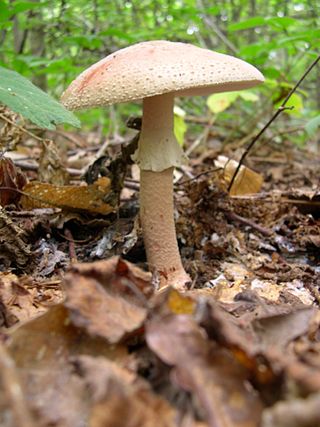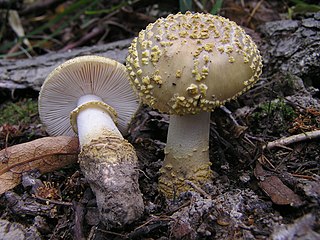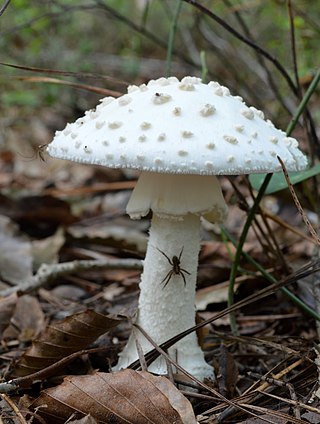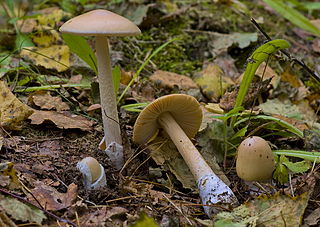
Amanita muscaria, commonly known as the fly agaric or fly amanita, is a basidiomycete of the genus Amanita. It is a large white-gilled, white-spotted, and usually red mushroom.

The blusher is the common name for several closely related species of the genus Amanita. A. rubescens, or the blushing amanita, is found in Europe and eastern North America, and A. novinupta, also known as the new bride blushing amanita, is found in western North America. Both their scientific and common names are derived from the propensity of their flesh to turn pink upon bruising or cutting.

Amanita calyptroderma also known as coccora, coccoli or the Pacific amanita, is a white-spored mushroom that fruits naturally in the coastal forests of the western United States during the fall and winter and spring.

Amanita velosa, commonly known as the springtime amanita, or bittersweet orange ringless amanita is a species of agaric found in California, as well as southern Oregon and Baja California. Although a prized edible mushroom, it bears similarities to some deadly poisonous species.

Amanita ocreata, commonly known as the death angel, destroying angel, angel of death or more precisely western North American destroying angel, is a deadly poisonous basidiomycete fungus, one of many in the genus Amanita. The large fruiting bodies generally appear in spring; the cap may be white or ochre and often develops a brownish centre, while the stipe, ring, gill and volva are all white. A. ocreata resemble several edible species commonly consumed by humans, increasing the risk of accidental poisoning. Mature fruiting bodies can be confused with the edible A. velosa, A. lanei or Volvopluteus gloiocephalus, while immature specimens may be difficult to distinguish from edible Agaricus mushrooms or puffballs.

Amanita franchetii, also known as the yellow veiled amanita, or Franchet's amanita, is a species of fungus in the family Amanitaceae.

Amanita augusta is a small tannish-brown mushroom with cap colors bright yellow to dark brown and various combinations of the two colors. The mushroom is often recognizable by the fragmented yellow remnants of the universal veil. This mushroom grows year-round in the Pacific Northwest but fruiting tends to occur in late fall to mid-winter. The fungus grows in an ectomycorrhizal relationship with hardwoods and conifers often in mixed woodlands.

Amanita suballiacea is a species of Amanita found in US coast of the Gulf of Mexico occurring with Quercus and Pinus.

Amanita veldiei is a species of Amanita found in South Africa

Amanita canescens is a species of Amanita found from Connecticut to Alabama, United States.

Amanita flavipes is a species of Amanita found in oak and conifer forest of China, India, Japan, Pakistan, and South Korea.

Amanita polypyramis is a species of Amanita found in the Eastern United States. It is a large, bone white mushroom with a chlorine-like odor. Its species name, polypyramis, refers to the pyramid-like warts on the surface of the pileus.

Amanita carneiphylla is a species of Amanita found in Western Australia growing among Eucalyptus, Banksia, and Allocasuarina

Amanita sculpta is a species of Amanita. It is distinctive because of its large size, with caps 10 to 27 centimetres in diameter. The cap's appearance, beige and dark brown with pileal warts, has been compared to that of a chocolate chip cookie.

Amanita betulae is a species of Amanita found in growing in birch and mixed hardwood in Europe

Amanita gioiosa is a species of Amanita found in Italy growing among Arbutus, chestnut, oaks, and pines.

Amanita neoovoidea is a species of Amanita found in China and Japan

Amanita protecta is a species of Amanita found in California growing solitary among Quercus agrifolia and Monterey pine.

Amanita flavescens is a species of Amanita found in Sweden and Norway.




















